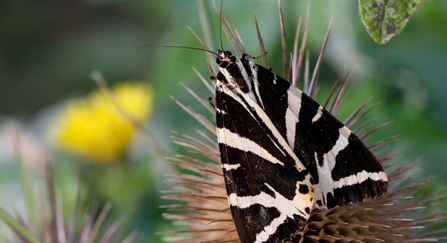There are plenty of cool wooded areas and shaded paths through the corridors of high gorse and bracken in which to escape the heat should it continue into September. Now that the animals are free to roam be aware that they may have found the shady patches before you. Sadly, there are patches of ling (Calluna vulgaris) where the entire plant above ground had been burned crisp and brown by the fierce sun among the usual August purple spread. Very young ling plants seem to be more resilient, perhaps because they are rooted in slightly damper soil and protected by surrounding plants. By mid-August, the yellow tormentil which usually flowers non-stop from late spring to autumn, seemed to be saving energy with fewer flowers visible but the colony of dwarf furze (Ulex minor), near the fenced-off bird sanctuary, was in full flower, clearly thriving in the heat, the East of England being its northernmost territory in Europe. The colony is slowly spreading, young plants almost swamped by ling, and the mature bushes, mostly under a metre tall, all intertwined with ling over a fringe of tormentil. The whole plant is on a smaller scale than European gorse, even the spines are slightly softer, making it more palatable to the grazers. It’s still pretty prickly though, so like European gorse and brambles, offers excellent cover for small creatures and perches for birds. The seed has evolved to germinate most readily after fire.
Rob Insall, who monitors the extensions for butterflies and dragonflies, reported in mid-August that migrant hawker dragonflies have arrived and a few common darters but it’s been a poor year for them and all of the Odonata (dragonflies and demoiselles) so far, except the banded demoiselles. Butterflies picked up after a slow start with plenty of whites, meadow browns, gatekeepers, and even some wall browns and white admirals - both firsts in his five years of surveys. Brimstones have had a good long season and the first clouded yellow appeared.
Terry Dunk and David Rayner run regular moth trapping sessions overnight on the main reserve. The moths are released after being identified and counted. Two sessions in July recorded a total 639 moth of 126 species, indicating the variety of moths in and around the main reserve. After the 10th August session, Terry reported: ‘Unfortunately after a bumper July it just had to be followed by a deflated August. We had more than we bargained for after switching on the lights as we were inundated with a plague of flying ants and other winged little beasties. Our traps were alive with everything but moths in just a few minutes! Along with increased bat activity not helping our cause, we ended up with a total of 74 moths of 39 species. A night to forget and thankful I only had a few insect bites for my troubles.’ Deciphering the scientific names would take an entire article but the common names are a delight in themselves: among those trapped were nutmeg, straw dot, tawny-barred angle, tree-lichen beauty, birch marble (looks like bird poo), common plume, mother-of-pearl, dusky and canary-shouldered thorn, and the spectacular Jersey Tiger, a day-flying moth with black and creamy-white striped forewings and bold orange underwings.
The heathland will continue to be monitored to understand how species and the various eco-systems have benefitted or suffered from the drought, and the impact of the free-ranging grazers. Gardening on sand, I try to get all new plants planted before Christmas to allow roots to get established to sustain the plants through their first year, as we are usually dry by April.
Margery Thomas

